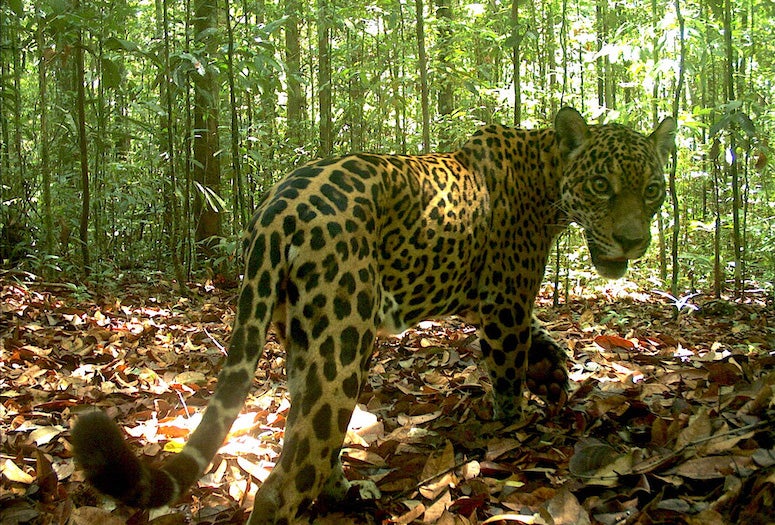By 2030, if the 30 by 30 initiative supported by more than 100 countries is successful, 30% of our land and ocean ecosystems will be designated protected areas meant to safeguard biodiversity and help limit the impacts of climate change.
However, a study by Rice University ecologist Lydia Beaudrot and collaborators reports for the first time that tropical mammals living inside protected areas are not spared the effects of human activity even when it occurs outside of the protected boundaries.


(Photo courtesy of Lydia Beaudrot)
Based on the largest long-term camera-trap wildlife survey of its kind to date, the research sheds light on how anthropogenic stressors such as human population density and habitat fragmentation impact 159 mammal species in 16 protected areas across three biogeographic regions. The study, published in Nature Ecology and Evolution, could inform biodiversity policymaking decisions by 30 by 30 participants.
Comprised of millions of images collected over multiple years from over 1,000 camera-trap sites, the data set was assembled by a large-scale network of research stations that agreed to implement a consistent data-collection protocol as part of a partnership between Conservation International, the Wildlife Conservation Society and the Smithsonian Institution.
“This data set is just phenomenal — it was a herculean effort unlike anything attempted before,” said Beaudrot, an assistant professor of biosciences.
The study found that specialist species — which occupy specific habitats only — thrive when habitat fragmentation is low and are generally more susceptible to the negative impacts of human activities like hunting and land use than generalist species, which are able to live in more diverse habitats. Thus, a white-bellied pangolin living in the Bwindi Impenetrable National Park in Uganda should shuffle closer to its center, since specialists are likely to fare better the farther inward they are from the edge of a protected area.

“Habitats are more varied at the edge of the protected area,” said Asunción Semper-Pascual, a postdoctoral researcher at the Norwegian University for Life Sciences and the lead author on the study. “There is usually this difference between forest cover and open landscape, such as an area used for agriculture, etc. Some generalist species thrive in this kind of diverse setting because it provides access to different resources.”
Generalist species, such as the tayra — a dog-sized omnivore in the weasel family that is at home both under forest cover and in grasslands or cropland, only thrive near the edge of protected areas if human population density there is low.
Understanding species-specific responses to different anthropogenic stressors can help set conservation priorities and guide protected-area management — locally by focusing on the most vulnerable species in a region and globally by highlighting how landscape-scale factors impact biodiversity beyond the protected perimeter.
“We have to think about the situation holistically,” Beaudrot said. “Conservation is going to work best when it’s tackled in specific contexts and in concert with the people who live there so as to create win-win situations for both the people and the wildlife.”

“As more protected areas are created, we need to think carefully about the factors both within and outside protected areas that influence biodiversity,” Semper-Pascual said.
The Research Council of Norway (NFR301075) and the National Science Foundation (2213568) supported the research.
- Peer-reviewed paper:
-
Occurrence dynamics of mammals in protected tropical forests respond to human presence and activities | Nature Ecology and Evolution | DOI: 10.1038/s41559-023-02060-6
Authors: Asunción Semper-Pascual, Douglas Sheil, Lydia Beaudrot, Pierre Dupont, Soumen Dey, Jorge Ahumada, Emmanuel Akampurira, Robert Bitariho, Santiago Espinosa, Patrick Jansen, Marcela Guimarães Moreira Lima, Emanuel Martin, Badru Mugerwa, Francesco Rovero, Fernanda Santos, Eustrate Uzabaho and Richard Bischof
https://www.nature.com/articles/s41559-023-02060-6 - Image downloads:
-
https://news-network.rice.edu/news/files/2023/04/PA_edge_1_LG.jpg
CAPTION: A protected area — the Bwindi Impenetrable National Park in Uganda — that is bordered by cropland. (Photo by Douglas Sheil/Wageningen University & Research)
https://news-network.rice.edu/news/files/2023/04/PA_edge_2_LG.jpg
CAPTION: Generalist species can benefit from the heterogeneous habitat at the edge of a protected area, while specialists fare better farther inward from the edge. (Bwindi) (Photo by Douglas Sheil/Wageningen University & Research)
https://news-network.rice.edu/news/files/2023/04/PA_jaguar_LG.jpg
CAPTION: Though a generalist species, jaguars (Panthera onca) such as this one in the Caxiuana National Forest in Brazil are more likely to occupy sites farther from the edge of protected areas, which is reflective of specific factors including hunting and prey scarcity in areas accessible to humans. (Image courtesy of the Tropical Ecology Assessment and Monitoring Network)
https://news-network.rice.edu/news/files/2023/04/tayra_LG.jpg
CAPTION: A tayra (Eira barbara), a generalist species, in Ecuador’s Yasuni National Park. (Image courtesy of the Tropical Ecology Assessment and Monitoring Network)
https://news-network.rice.edu/news/files/2023/04/2303_LydiaBeaudrot_LG.jpg
CAPTION: Lydia Beaudrot is an assistant professor of biosciences at Rice.
(Photo courtesy of Lydia Beaudrot)
https://news-network.rice.edu/news/files/2023/04/SemperPascual_photo.jpg
CAPTION: Asunción Semper-Pascual is a postdoctoral researcher at the Norwegian University for Life Sciences and the lead author on the study. (Photo courtesy of Asunción Semper-Pascual)
- Video:
-
https://youtube.com/shorts/FThgexkMFw0?feature=share
CAPTION: An ocelot (Leopardus pardalis) in Yanachaga Chimillén National Park in Peru. The ocelot is a generalist species that can be found in rainforests, dry forests and savannas and is listed as being of “least concern” according to the International Union for Conservation of Nature’s Red List of Threatened Species.
https://youtube.com/shorts/SGcCZ96luP0
CAPTION: A giant anteater (Myrmecophaga tridactyla) in Yanachaga Chimillén National Park in Peru. The giant anteater is a generalist species that can be found in rainforests, dry forests and savannas and is listed as “vulnerable” according to the International Union for Conservation of Nature’s Red List of Threatened Species. - Links:
-
Empty forests and extinction filters project:
https://www.nmbu.no/forside/en/projects/empty-forests
Wiess School of Natural Sciences: https://naturalsciences.rice.edu/
Department of Biosciences: https://biosciences.rice.edu/
- About Rice:
-
Located on a 300-acre forested campus in Houston, Rice University is consistently ranked among the nation’s top 20 universities by U.S. News & World Report. Rice has highly respected schools of Architecture, Business, Continuing Studies, Engineering, Humanities, Music, Natural Sciences and Social Sciences and is home to the Baker Institute for Public Policy. With 4,552 undergraduates and 3,998 graduate students, Rice’s undergraduate student-to-faculty ratio is just under 6-to-1. Its residential college system builds close-knit communities and lifelong friendships, just one reason why Rice is ranked No. 1 for lots of race/class interaction and No. 4 for quality of life by the Princeton Review. Rice is also rated as a best value among private universities by Kiplinger’s Personal Finance.

